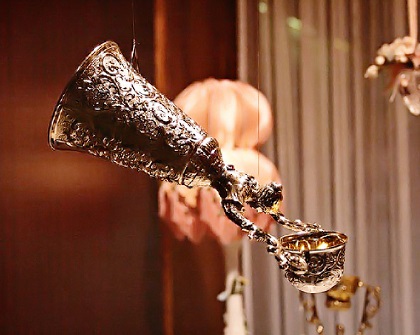 In Germany parents start thinking about the daughter’s wedding quite far in advance.
In Germany parents start thinking about the daughter’s wedding quite far in advance.
- When a baby girl is born, the parents, and later on the little girl herself, will save pennies used to buy the wedding shoes in future.
- According to German wedding traditions, when a baby girl is born in Germany, several trees are planted in honor of her birth. When her wedding date is set, the trees are sold, and the money is used for her dowry.
- In some regions – the agreed upon abduction of the bride by her (and/or the groom’s) friends.
- Engagement rings are worn on the left hand. After the ceremony, the same rings are placed on the right hand. Engagement rings are commonly plain gold bands.
- A couple should spend some time some time cleaning up – after their friends and family dropped loads of china in front of the door and made a huge mess during the Polterabend. Only the couple has the privilege to toss the china down the stairs the night before the ceremony. Each guest might bring a special food. This occasion continues until the early hours of the morning and may be followed by a breakfast at the bride’s parents’ home.
- This custom is figurative and is to wish a happy, lucky life to the new couple. The German proverb “Scherben bringen Glück,”( translated as ‘broken crockery brings you luck,’) originates from this custom.
- Driving the bride’s furniture to her future home in a cart, with driver and musicians. At the threshold, the bridegroom greets her with a jug of beer; she gives him a pair of shoes, a shirt she spun and wove, and a key to her bridal chest.
- A wedding contract called ‘Heiratsvertrag’ (previously ‘Fraktur’) is made, a precursor to prenuptial agreements.
- The creation of a wedding newspaper by the friends and family of the bride and groom. This newspaper, or booklet, is filled with pictures, articles and stories of the engaged couple. The newspaper is sold at the wedding reception, to assist with the expenses of the honeymoon.
Germany has a variety of lovely towns in which a couple can choose to hold a marriage ceremony. Cities such as Munich, Dusseldorf and Berlin are renowned cultural centers that attract tourists from around the world.
The bride usually wears an heirloom gown, or one from an older sister or her mother, or purchases a new gown. Each has her own elaborate wedding crown constructed of wire, tinsel, artificial flowers, pearls, ribbon and pins. It is bad luck to try on someone else’s crown, or take her own off before midnight, when it is replaced by a bonnet. The bridegroom, best man, and bridesmaids dance around the blindfolded bride. She must catch a bridesmaid (the next to marry). Married women then tie the bridal bonnet on this maid, who must dance with all the bridegroom’s male relatives around three lit candles on the floor.
Young girls wear wreaths made of fresh flowers if they are pages in the ceremony. Orchids are most popular in modern weddings. ‘Roping the couple’ is a tradition in which red ribbons and garlands of flowers are placed across their exit; the bridegroom must buy their ransom with money or the promise of a party.
It is customary for the ‘best man’ to steal the bride from the reception and take her to a local pub, where they drink champagne until the groom finds them. Then the groom has to pay for all that they drank. Later, friends of the couple block all the reception site exits with ribbons and garlands. When the couple is ready to leave for their honeymoon, the groom must pay a toll to exit, usually the promise of another party.
The couple leads the way in a car decorated with a huge bouquet of flowers fastened to the hood, with all the guests following them, loudly honking their horns. The guests will have tied white ribbons to their cars’ antennas. Onlookers will also honk their horns in honor of the wedding party.
At the newlyweds’ home, the couple share a bite of bread, symbolizing they never will be short of food. In some regions, the bride is pushed into the kitchen at once, as a housewife, she must first put salt in the soup. A more common tradition among newlyweds involves the groom carrying the bride across the threshold of their home.
The party that follows after the wedding lasts long into the night. Germans also love to play tricks on the new couple. Sometimes a bunch of friends can be seen laboriously lugging furniture and other items onto the roof of the couple’s home while they are away at church.
Germany’s most popular honeymoon destinations are in the Bavarian Alps and the Black Forest.
Related articles:
German Wedding Traditions: Old Customs That Still Exist Today
How to Saw a Log
Champagne, Bridal Soup and a Saw!
German Wedding Tips
German Wedding Traditions
Getting Married in Germany







